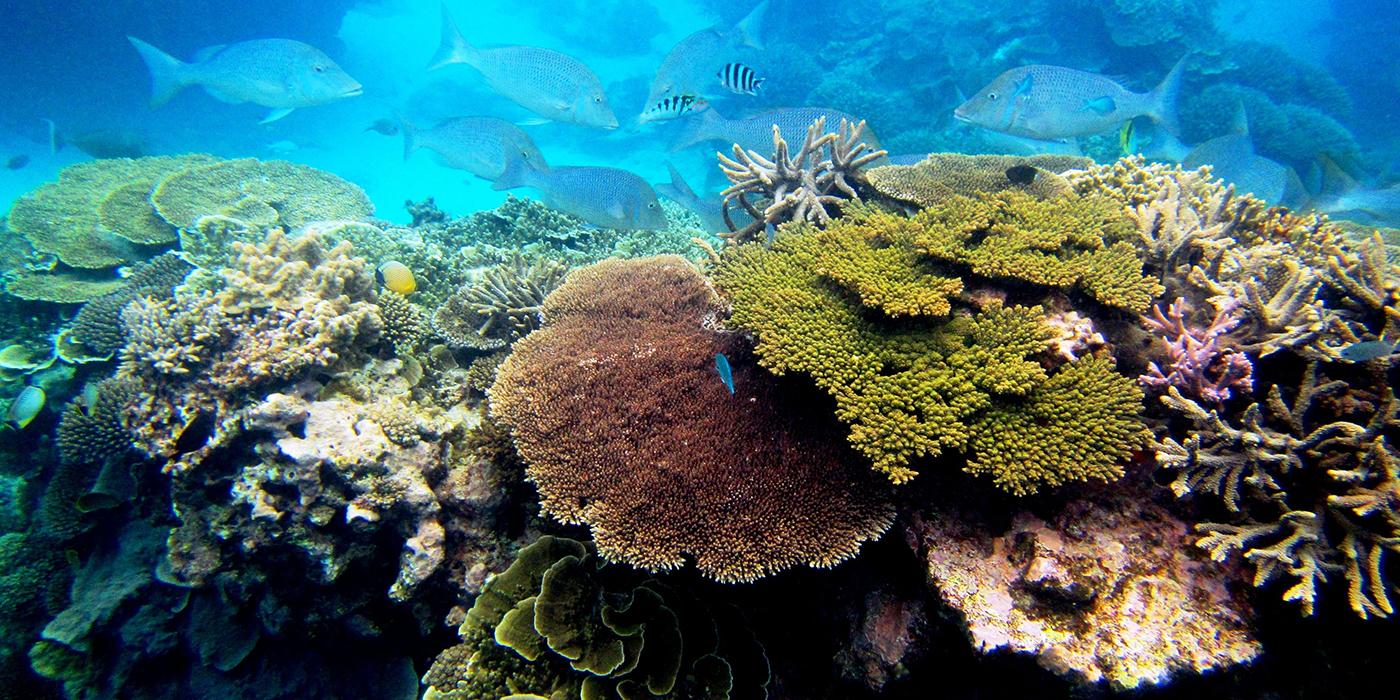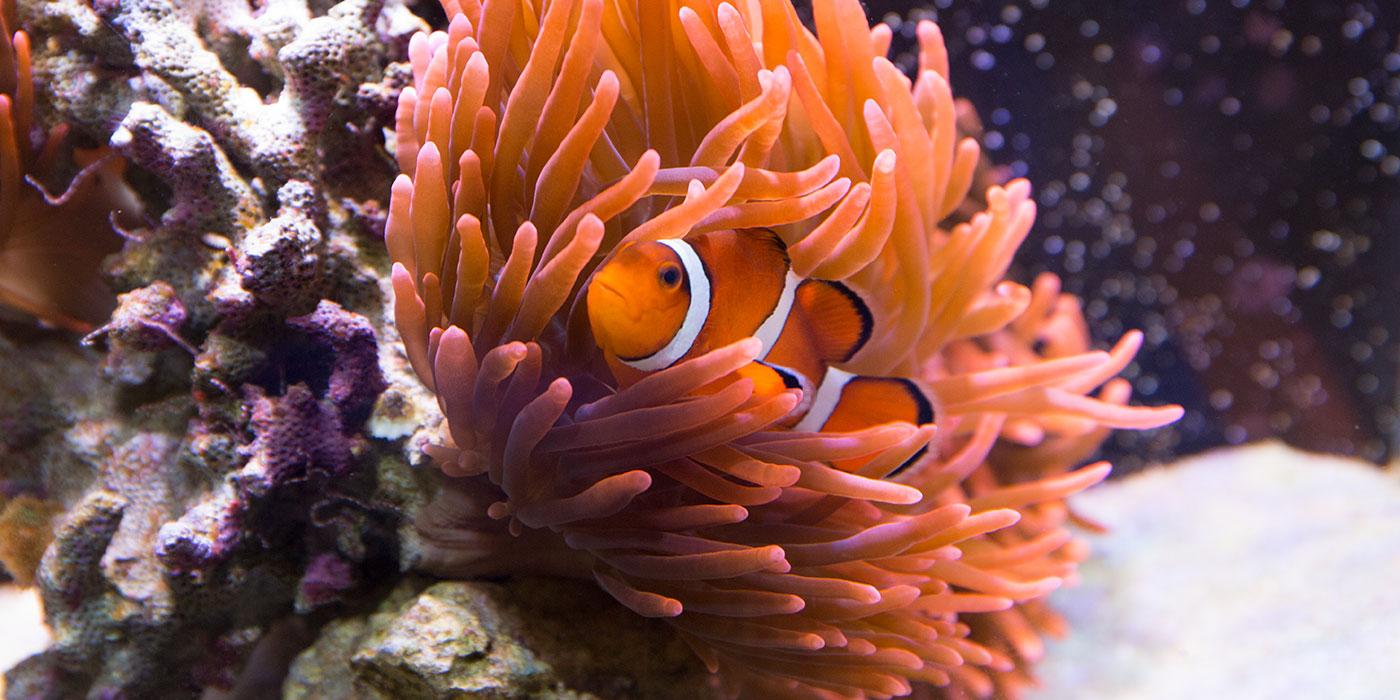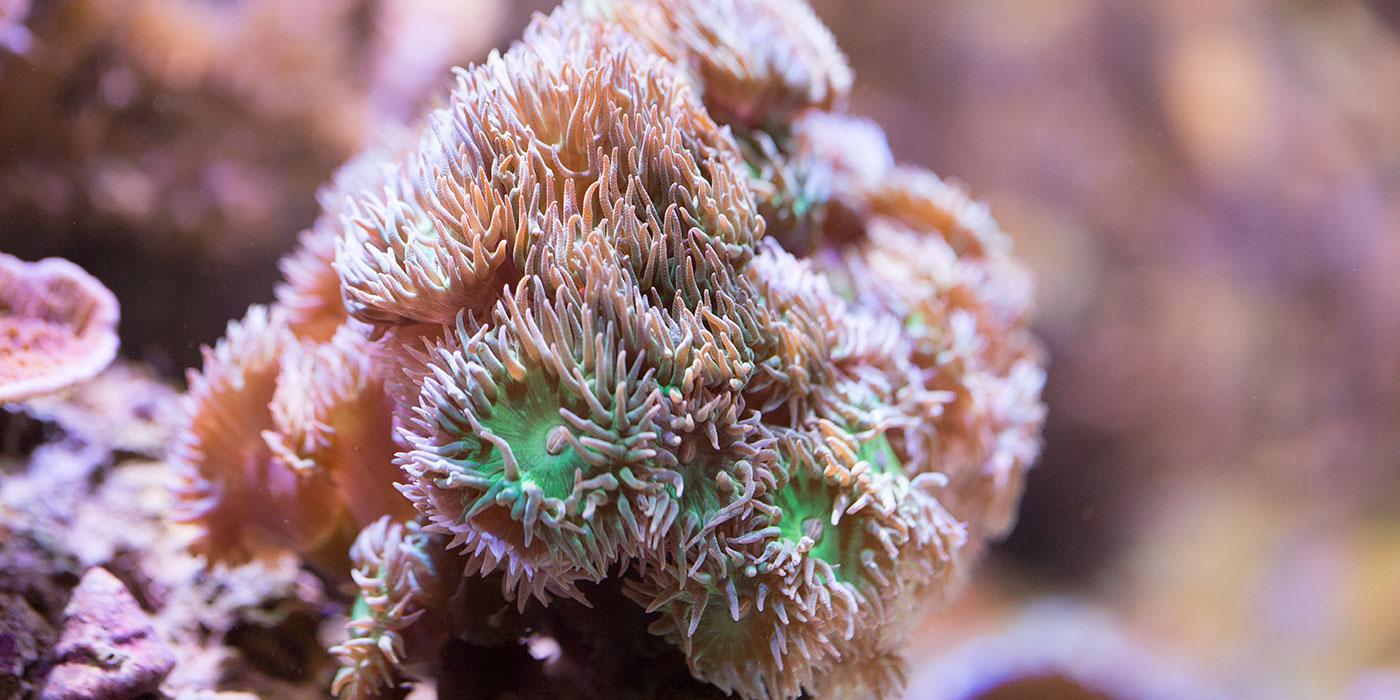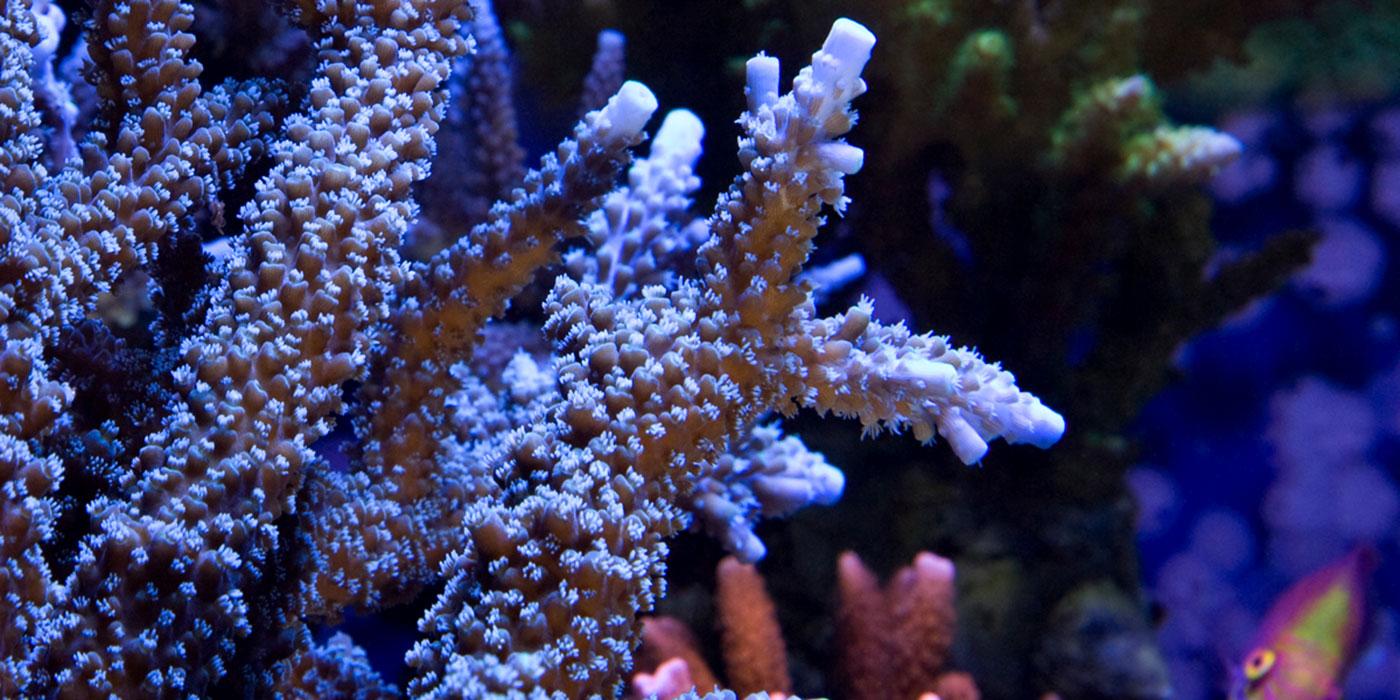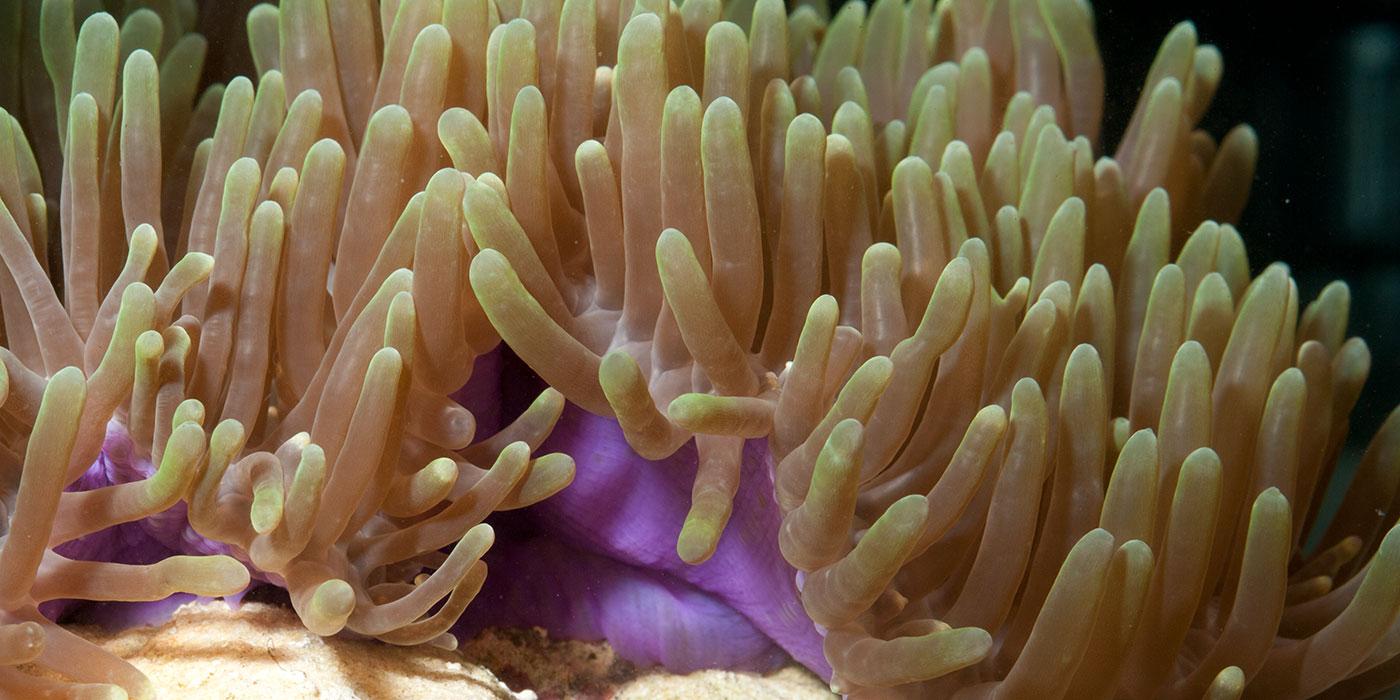Physical Description
Corals, anemones and jellies are related and all classified in the phylum Cnidaria or “stinging needles.” The animals in this group are aquatic, possess stinging cells within their tissues and have a body plan characterized by radial symmetry, which allows all parts of their bodies to be equally receptive and responsive to predator and prey. These animals have a single opening that serves as both the mouth and the anus. Tentacles with stinging structures, called nematocysts, usually surround this opening. These stinging cells, triggered by touch or chemical stimulus, can contain toxins or can be sticky.
Within the phylum Cnidaria, the class Anthozoa includes corals, anemones, sea pens and seafans. Anthozoa consists of 10 orders and thousands of species. Adults are attached to the seabed, but their larvae are free-floating and can drift to new settlements. Anthozoans can secrete a nonliving substance around the outside of the body to support and protect their soft body tissues. Coloration can vary from red, pink and purple to yellow, blue and orange. While some are only a few inches tall, others can scale several feet.
The fossil record of Anthozoa extends back 550 million years. The oldest known Anthozoans, polyp-like fossils, come from the Vendian (late Precambrian) period. True corals appeared later, during the Cambrian period. Some species living today first appeared in the middle Triassic period — around the same time as early dinosaurs!
Coral reefs rival rainforests in diversity of life. Together, they hold the most diverse ecosystems on the planet. Living reefs cover more than 360,000 square miles (936,000 square kilometers) and harbor one of every four ocean species known to man, yet they cover less than 0.1 percent of the entire ocean.
They also provide more than a home for fish and other reef dwellers; coral reefs act as an important buffer between land and the daily erosion from waves or occasional storm surges. They often protect a back-reef area of rich productive habitats creating a nursery for the juvenile stages of ocean life.
Coral reefs also support the tourist industry and a strong fishing industry. Organisms found on coral reefs have provided key ingredients for innumerable medical compounds that treat everything from asthma and cancer to HIV and still show potential for future pharmaceutical discoveries.
General Anthozoa Characteristics
There are many subclasses and orders with varying characteristics under the class Anthozoa, including:
Order Scleractinia, Stony Corals: Stony or reef-building corals form a skeleton made of calcium carbonate under the polyps to create the hard structure that most people recognize as coral. These corals are responsible for forming the base structure of coral reefs. As older polyps die off, new polyps continue to build calcifications on the old skeletons, allowing for the huge scale of reefs in the Caribbean and the Great Barrier Reef. Not all stony corals are reef-building, though, as some are not able to produce enough calcium carbonate to facilitate reef formation.
Subclass Octocorallia, Octocorals: Despite sharing a similar appearance with stony corals, soft corals, sea pens, gorgonians and sea fans do not build the hard, calcium-carbonate skeleton of stony corals. Instead, these corals may create some internal structural supports that allow them to grow vertically but still sway with ocean currents. Soft corals are always colonial and grow with eight-fold symmetry, which means their tentacles come in groups of eight — hence the name Ocotocoral. Octocorals include the orders Alcyonacea and Helioporace.
Order Corallimorpharia, Anemone Corals or Mushroom Corals: Members of this order are sometimes called anemone corals or mushroom corals because they resemble anemones more closely than other types of corals due to their large, flat, disc-like shape and short tentacles. They grow like wheel spokes, radiating from a center and forming concentric circles. The diameter of the circle increases as they grow. This order is extremely popular in home aquariums.
Order Zoantharia, Zoanthids: Zoanthids have long, prominent tentacles arranged in two rows. Unlike stony and soft corals, Zoanthids incorporate sand and other substrate into their colonies for structure. They may live as individual polyps or in colonial groups.
Order Actiniaria, Anemones: Larger anemones tend to be solitary while smaller species may use asexual reproduction to propagate and live in large concentrations when there is suitable habitat. Anemones come in a wide range of colors, some owing their coloration to the zooxanthellae, microscopic algae, they host. Anemones have a disc-shaped bottom they use to attach themselves to rocks, in crevices and on other suitable surfaces, including the shells of other marine invertebrates.
Subclass Ceriantharia, Tube-dwelling Anemones: This subclass looks similar to sea anemones, but tube-dwelling anemones are known for being solitary and living buried in soft sediments. They live inside tubes made of secreted mucus and organelles, and can recede into these tubes for protection. Ceriantharia includes the orders Spirularia and Penicillaria.
Size
Native Habitat
Anthozoans are found from intertidal zones to deep ocean trenches, in both warm and cold waters. Reef-building corals are only found in shallow tropical and subtropical waters. Anthozoa are found in the largest numbers in warm, tropical waters in coral reef habitats.
Lifespan
It is estimated that most reefs are between 5,000 and 10,000 years old, with some actually tracing their beginnings back 50 million years. It is unclear how long the life span of an individual coral or anemone is.
Food/Eating Habits
Some corals receive their nutrition from mutualistic zooxanthellae that require sunlight for photosynthesis, the by-products of which are sugars consumed by the hosting coral. Corals may also feed by capturing prey with their stinging nematocysts or by feeding on “marine snow,” a shower of organic materials and biological debris falling from upper waters to the deep ocean. Depending on their size, corals may catch prey varying in size from microscopic zooplankton to small fish.
At the Smithsonian's National Zoo, anemones and corals are housed under special lighting fixtures and receive a mixture of minced clams, fish and shrimp.
Reproduction and Development
Corals can reproduce sexually and asexually. Asexual reproduction happens in the form of budding that occurs when a parent polyp (produced by sexual reproduction) divides, creating a colony of genetically identical but individual animals. Corals also fragment during storms and these pieces can regrow into new colonies. A colony can grow to hundreds of thousands of individual polyps.
Corals reach sexual maturity at different ages, varying by species and colony size. Some can mature and reproduce successfully in as little as four years, while others can take decades to reproduce. Sexual reproduction usually takes place through broadcast spawning of gametes or internal brooding of larvae.
When broadcast spawning, corals release both eggs and sperm into the open water in a synchronized spawning event triggered by a variety of environmental cues. Fertilized larvae float in the water column until they settle in a suitable place to attach and begin a new colony. Sexual spawning allows larvae to be carried to other areas, spreading new genetic material to a different habitat.
Conservation Efforts
Coral reefs are threatened by disease, climate change, over-fishing, pollution, over-development of coastal zones and the aquarium trade. Fishing with cyanide and explosives has reached epidemic levels, and run-off from over-fertilization and insecticides has further injured coral structures by fueling the growth of competing algae.
The steady increase of silt loads into waterways from destructive farming and logging practices has also put pressure on already deteriorating reefs. The trade of both fish and corals for hobby tanks gives low-income communities near reefs a source of profit, which encourages the destruction and collection of these organisms.
In the past few decades, one-tenth of all coral reefs have been destroyed and one-third have been seriously degraded.
The greatest threats to reefs are rising water temperatures and ocean acidification linked to rising carbon dioxide levels. High water temperatures cause corals to lose the microscopic algae that produce the food corals need — a condition known as coral bleaching. Severe or prolonged bleaching can kill coral colonies or leave them vulnerable to other threats. In the Caribbean alone, approximately 90 percent of hard coral (reef-building) cover has been lost in the past 30 years, largely due to increased bleaching events fueling disease.
Coral reefs rival rainforests in diversity of life, and together they hold the most diverse ecosystems on the planet. Living reefs cover more than 360,000 square miles (936,000 square kilometers) and harbor one of every four ocean species known to man, yet they cover less than 0.1 percent of the entire ocean.
Coral reefs provide more than a home for fish and other reef denizens; they also act as an important buffer between land and the daily erosion from waves or occasional storm surges. They often harbor a back-reef area of rich productive habitats creating a nursery for the juvenile stages of ocean life.
Coral reefs also support the tourist industry and a strong fishing industry; coral is used as a basic building substrate and incorporated into the production of cement. Organisms found on coral reefs have provided key ingredients for innumerable medical compounds that treat everything from asthma and cancer to HIV and still show potential for future pharmaceutical discoveries.
Smithsonian scientist Mary Hagedorn is leading the field of coral cryopreservation, which allows scientists to bank coral sperm and stem cells for research and repopulation. Hagedorn’s team created the first frozen repositories for nine coral species in the U.S. and Australia. These repositories contain 1 trillion frozen sperm and 3 billion frozen larval cells.
The Smithsonian also has a research program studying Caribbean coral reef ecosystems. One location of study is the Carrie Bow Cay Field Station. The team of scientists stationed there gives an annual report on the corals and their environment. You can check daily reports on water conditions and weather effecting the corals here.
Help this Species
- Share the story of this animal with others. Simply raising awareness about this species can contribute to its overall protection.
- Try fundraising for conservation organizations in new and fun ways. You could donate your birthday to conservation, host a bakesale to benefit wildlife or Adopt a Species!
Meet the Animals
The Smithsonian's National Zoo's Coral Lab, located in the Amazonia Science Gallery, exhibits several species, including anemones, corals, crustaceans and clams. The Lab helps visitors feel a more personal connection with corals and understand the important role corals (and coral reefs) play in ocean health.
Since 2006, the Zoo has participated in a joint effort with other zoos, aquariums and universities to help establish a population of two species of endangered stony corals found only in the Caribbean — Elkhorn Coral (Acropora palmata) and Staghorn Coral (Acropora cervicornis).
The following species can be seen in the Coral Lab:
Order Scleractinia, Stony Corals: Staghorn coral, Elkhorn coral, Bushy acropora coral (Acropora sp.), Elegance coral (Catalaphyllia jardinei), Open brain coral (Trachyphyllia geoffroyi), Montipora coral (Montipora sp.), Plate coral (Fungia sp.), Branching hammer coral (Euphyllia sp.), Birdsnest coral (Seriatopora sp.), Brain coral (Acanthastrea sp.), Lettuce coral (Pavona sp.), Trumpet coral (Caulastrea sp.), Cauliflower coral (Pocillopora sp.), Hump coral (Porites cylindrica), Golfball coral (Favia fragum), Suncoral (Tubastrea sp.), and Whisker or Duncan coral (Duncanopsammia axifugal)
Subclass Octocorallia, Octocorals (soft corals, sea pens, gorgonians and sea fans): Blue coral (Heliopora sp.), Gorgonian coral (Pseudoplexaura sp.)
Order Corallimorpharia (sometimes called anemone corals or mushroom corals): Ricordea florida and Corallimorphus sp.
Order Zoantharia, Zoanthids: Palythoa and Zoanthus
Order Actiniaria, Anemones: Rock anemone (Epicystis cruicifer), Blue carpet anemone (Stichodactyla haddoni), Ritteri anemone (Heteractis magnifica), and Rose bubble tip anemone (Entacmaea quadricolor)
Animal News

Leaf-tailed Gecko Treated for Skin Cancer With Chemotherapy


